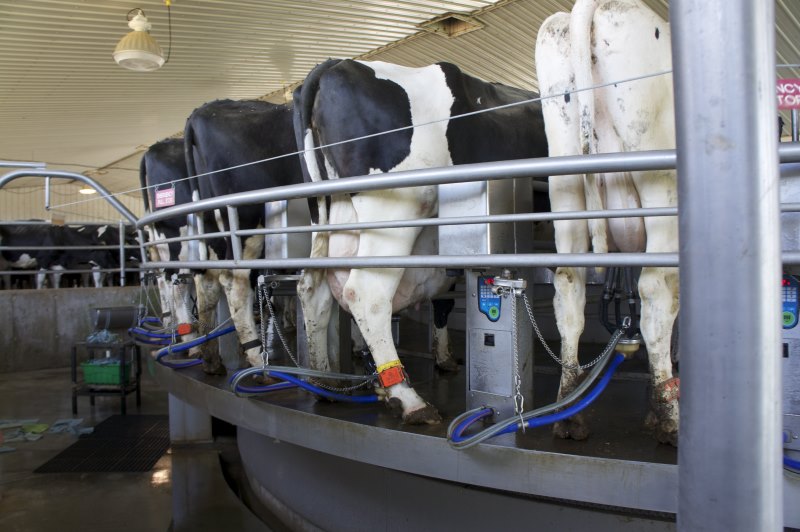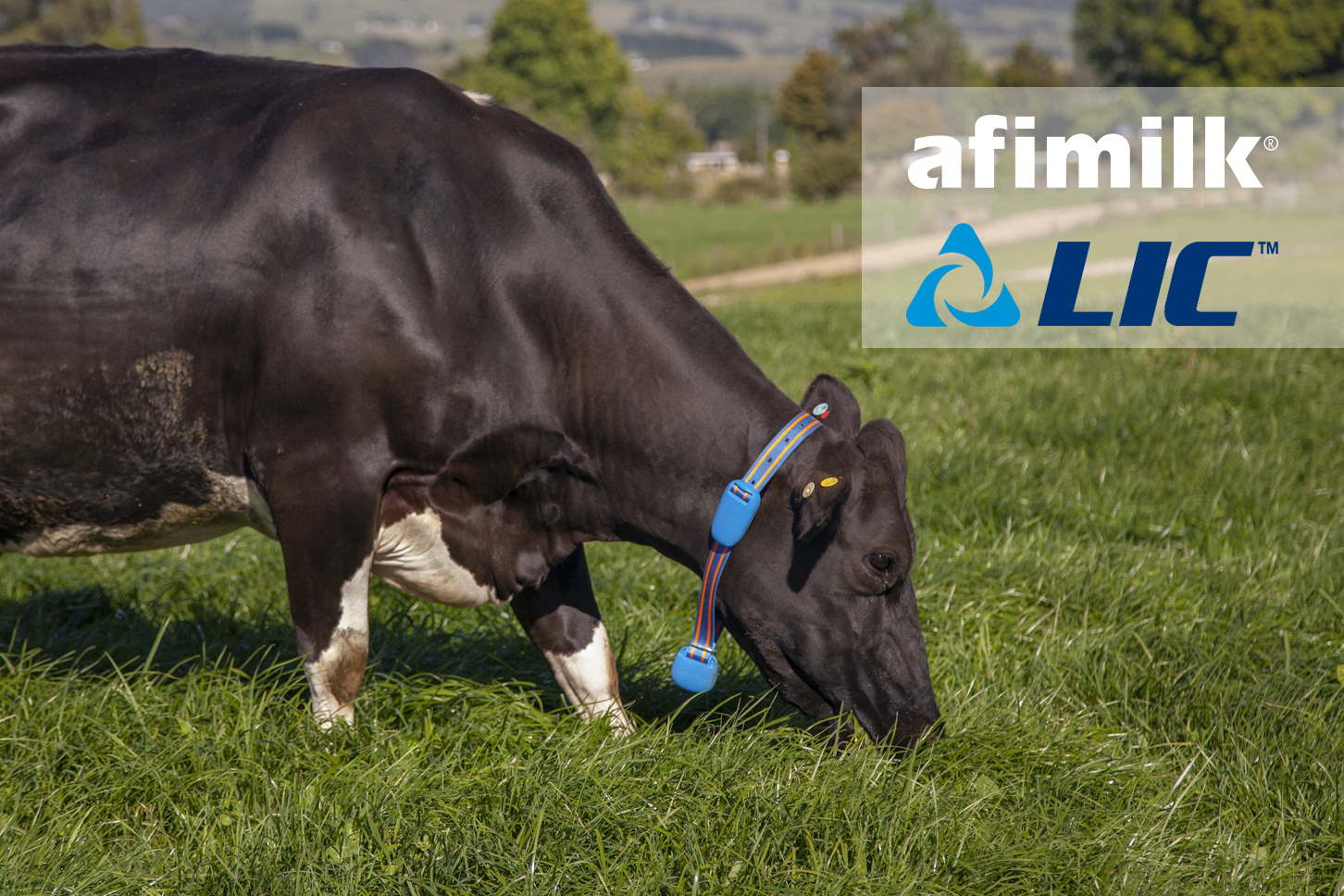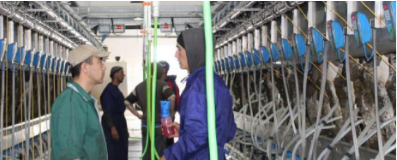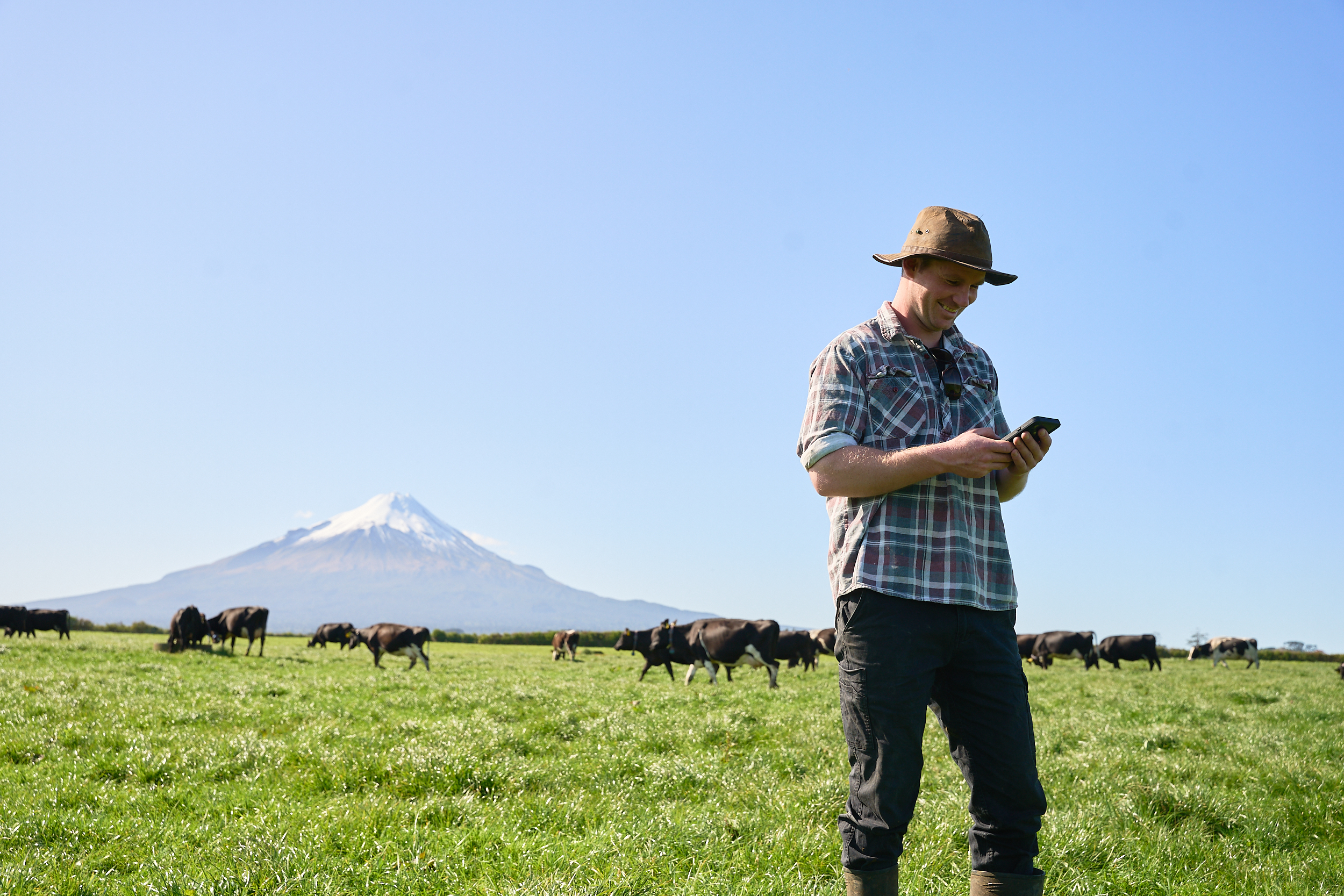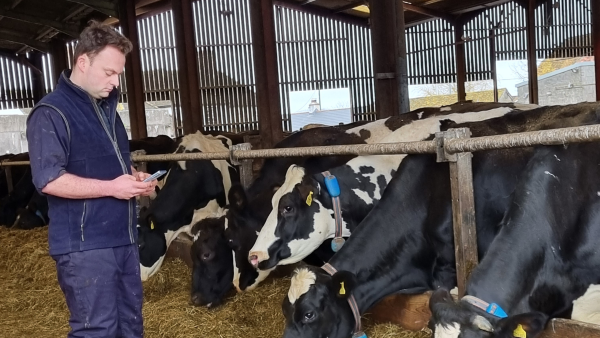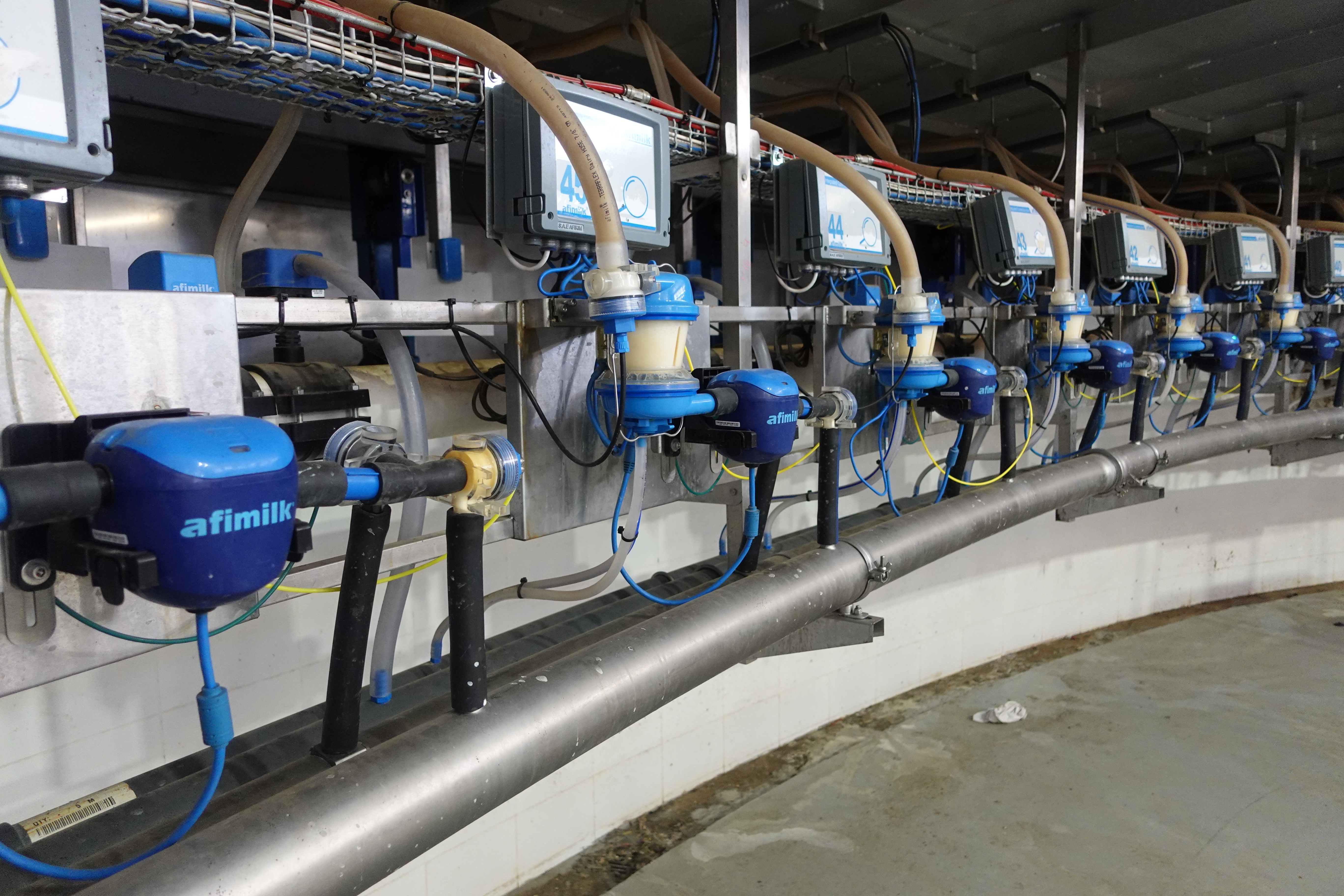Steve Eicker 1, Steve Stewart 2 , David Reid 3 and Paul Rapnicki 2
1 King Ferry, New York
2 University of Minnesota, St. Paul, Minnesota
3 Hazel Green, Wisconsin
Introduction
For many dairies, the parlor is the limiting constraint. If the parlor is being fully utilized, increasing the amount of milk harvested per hour is the only alternative to building a new parlor or enlarging the existing parlor.
Milk production per hour is the product of milk per cow and cows per hour, in that order.
Because the percentage-of-time that a unit is actually on the cow is typically between 25 and 40%, increasing milk per cow almost always results in more total milk per hour than increasing cows per hour. The ideal intervention improves both milk production and parlor throughput. For instance, improved mastitis control both increases milk yield and also improves parlor cow flow.
These are the major factors influencing parlor throughput:
- How fast cows enter the parlor
- How soon units are attached
- How soon peak flow rate is achieved after unit attachment
- How soon units are detached
Again, these are not independent. For instance, it would seem logical that incomplete preparation would be a method to decrease the time that units are attached. However, Smith, et al (1999) provided the following data to refute this assertion. They compared two rotary 60 parlors, both with 5 milkers. One dairy used a full udder preparation, the other was strip only.
| Prep | Seconds | Theory CPH | Actual CPH | Time milked | Cows/ Labor Hr | % of Theory | Milk Yield |
|---|---|---|---|---|---|---|---|
| Full | 8:00 | 450 | 336 | 3X | 67 | 75% | 65 |
| Strip | 7:80 | 462 | 283 | 2X | 57 | 61% | 57 |
Note that the full prep required the rotary to spin more slowly: 8.0 seconds per cow vs 7.8, so that in theory, the strip only should have produced 12 more cows per hour. But the actual cows per hour were 53 cows higher with the complete preparation. It is difficult to compare two different dairies, but in these data, the theoretical savings of a shortened preparation did not occur. This is a common finding. The typical effect of this intervention is longer unit-on time, so that the net effect is decreased cows-per-hour.
Furthermore, because poorly prepped cows tend to have slow milk let-down, and have unit on longer, their average flow rates are less, the units are attached longer, and they likely spend more time in low flow conditions. This requires lower vacuum levels to ensure fewer traumas to the tissues, but these lower vacuum levels slow milking, promotesquawks, and increase the incidence of falloffs.
In contrast, a well-prepped cow will let down her milk rapidly, and milk out rapidly and completely. Her average flow rate will be higher, so that the line vacuum can be higher to maintain the same teat-end vacuum. This decreases squawks, fall-offs, and reattaches.
Shortened unit-on-time – especially less time in low flow conditions – also appears to have dramatic long term effects. Decreasing the time in low flow is the key. Low flow can occur either at the start (due to poor prep), or at the end (over-milking). We have found better teat end conditions, a decrease in mastitis, and faster let-down and faster milk-out in properly prepped cows. The long term effect on the comfort of the cow is evidenced by dramatic increases in the speed of parlor filling. In summary, better milking preparation causes faster let-down and better milk-out, allows shorter unit-on times and permits use of higher vacuums, which leads to less squawks and reattaches, greater through-put, and less mastitis.
Because no change should be made on a dairy until it is first determined how the effects of that intervention should be measured, monitored, and evaluated, this paper will discuss the tools that have recently become available.
Milking Phases
The milk flow during the milking of a properly stimulated individual cow can be conceptualized as having 5 phases or intervals:
Phase 0 – Startup from attach to first flow – cisternal emptying?
Phase 1 – Ramp up from first flow to peak flow
Phase 2 – Peak flow: peak (plateau) milk flow
Phase 3 – Ramp down post-peak, still above take-off settings
Phase 4 – Dribble waiting for take-off to function
These hypothetical graphs demonstrate the different flow patterns between a well-prepped cow on the left, and a poorly prepped cow on the right. The vertical bars on the left graph identify the breaks between the phases described above. (Adapted from Stewart, 1993).One of the important goals in an efficient parlor operation is to have minimal reattaches.
Milking units should be attached once, stay on the cow, and be removed at the proper time.
There are a number of reasons units are reattached, including:
- No letdown – the unit is automatically removed by the take-off settings
- Poor unit alignment or improper adjustment
- Cow comfort – kicked off
- Early take-off – the unit is removed before the cow is done milking
- Low teat-end vacuum
- Milker training – reattaching units to harvest one last kilo – “overmilking”
On those systems that can report these data, the following two cows are typical:
- 7862 Reattach after 0.6 min 2 pounds idle for 0.8 min then 15 pounds
- 8178 Reattach after 4.5 min 21 pounds idle for 1.9 min then 1 pound
The first cow represents a cow with a failure of a proper letdown. The second cow is evidence of a poorly trained milker reattaching a cow that was already done milking. The effect of this reattachment is to hurt the cow, and damage her teats so that she will learn to dislike being milked. Because she will start associating the parlor with a painful experience, she will not let down her milk as well in the future, she will learn to kick at her units, and she will be reluctant to enter the parlor. Eventually, milkers will have to yell at her to get her to enter the parlor, which could have a deleterious effect on letdown of the other cows. Over-milking cows is a mistake. This did not seem to be a problem when farmers milked their cows by hand.
Monitoring Tools
Electronic identification and automated milk measuring have been available for nearly twenty years. The original purpose was to measure milk production of individual cows.
The potential benefits can be dramatically expanded depending on the data points available from the stall interface. These data vary by manufacturer.
Milking duration (Actual-milking-time; unit-on-time). The duration of time that the unit was actually on the cow. In practice, this is the vacuum-on time, as it is not possible to measure actual time of attachment. With rare exceptions, these are nearly identical. Some manufacturers are unable to report these data. Instead they have from first dump to last dump. With malfunctioning takeoffs, I have observed unit-on-times well over a minute longer than the duration recorded from dump-to-dump. In other cases, dump-to-dump overestimates milking duration because a final dump does not occur until a fixed time after the cow has exited the stall.
Consistent, accurate milking duration not only helps diagnose faulty take-off function, it is also used to calculate average flow rates, and percent utilization of milking units.
Artificially low durations as reported by some manufacturers will generate higher apparent average flow rates, and lower percent utilizations. It is unwise to compare parlors from different manufacturers until thereported duration measurements have been verified.
Precise parlor entry time allows two additional calculations: parlor-filling time, and gap between ID and attachment. Parlor filling time is a measurement of cow comfort in the parlor, and perhaps a reflection of cow handling. The gap between ID and attach provides an indication of the time lost due to cows waiting for units to be attached after entering the parlor.
Precise unit attachment time allows two important calculations: the order cows were attached, and the time between two adjacent attachments. It becomes easy to determine if two separate groups of cows were prepped, and then attached, or if all cows were prepped, then all cows were attached. There is likely an optimal time between prep and attachment to optimize let-down.
Average flow rate is the total milk yield divided by total duration. As mentioned above, the duration may not be correct for every system. In some systems, the average flow rate is the only available indication of milk flow, as no additional detailed data are available.
Peak flow is probably a proxy for milk letdown. Unfortunately, few manufacturers provide these data. One common method is to take the exact duration between dumps and divide the dump volume by the time. However, this really calculates instantaneous peak flow, which can occur merely because a cow shifts her weight (or the unit falls off), which empties the milk from the milk line into the meter. Indeed, Spencer (1997) reported that one manufacturer calculated peak flow rates in excess of 10 liters per minute, values which seem unlikely based on recent data.
Peak flow as a proxy for a letdown is only of value if an averaged flow rate is used.
Ideally, the flow should be averaged over a reasonable length of time (perhaps a full minute). The first minute is not full flow, so using the flow during the second full minute is likely more logical. Cows with very poor letdown can potentially have their peak flow later than the second minute.
But peak flow is at best an indirect measure of letdown. Recently, a major advancement in milk letdown has been made available. It is now possible to measure flow during the first 15 seconds, the intervals between 15 and 30 seconds, the flow between 30 and 60 seconds, and the total flow during 60 and 120 seconds, which is the standard measurement of peak flow. As well, these data allow calculation of the total amount of milk in the first two minutes and also the percent of total milk produced in the first minutes.
Time in low flow is the total time that the unit is attached that milk flow is less than 1 kg/min. Typically, this should include the time between attach and ramp up – Phase 0, and Phase 4. Phase 0 typically also includes inherent delays – the interval between vacuum-on and actual attaches, and the transit time from the teat to the meter. Our focus is actually Phase 4, which is hopefully as short as possible if the take-offs are properly functioning. There is some inherent delay in detecting low flow conditions. Some of this is necessary to account for both the unevenness of milk flow, and the discrete emptying (or measurement) of milk flow by the meter.
These flow data allow one to calculate the total milk yield in the first two minutes, and also the percent of milk yield harvested in the first two minutes.
One of the important goals in an efficient parlor operation is to have minimal reattached.
Milking units should be attached once, stay on the cow, and be removed at the proper time. The two most common causes of reattaches are poor prep / no letdown; and inappropriate reattachment. Certain manufacturers now provide some or all of the following data to evaluate falloffs. The first is the number of reattaches. Fewer than 5% of cows should be reattached. If this number is higher than this, or varies from shift-to-shift, examining detailed data is informative. The milk yield and duration before and after the reattach can readily identify if there were letdown problems, or unnecessary reattaches. Also, the time that the unit was unattached is available, so an assessment can be made as to how fast units are reattached after kick-offs.
With properly functioning take-offs, cows should not need to be detached manually.
Similarly, almost no cows should be put on manual override. Some systems can record this information so that milker training and performance can be monitored. With these detailed measurements, specific data are available for every cow every milking. The uses are numerous. Averages for each shift can be compared. Different prep routines can be compared. The effect of vacuum levels and pulsator settings can be better evaluated. Milker training and performance can be monitored and improved. Equipment malfunctions can be detected immediately.
Take-Off Settings
The ability to adjust take-off settings varies greatly by manufacturer and product line.
There are two general settings: minimum flow before automatic detachment and maximum time before detach. The minimum flow is typically calculated from the interval between dumps, and thus is really a time setting. Some systems have an additional “waiting” time, but this is virtually additive to the seconds between dump settings.
Few systems have yet implemented a maximum unit on-time. Using this feature has a dramatic effect on cow milkability. Without this setting, the distribution of duration will be right skewed – there will be some cows milked much longer than average. These cows may hold up an entire side, and all the cows still in the holding pen. If this is a rotary parlor, those cows may need to circle again – a potentially large disruption in cow flow.
A well-prepped cow should produce 25 pounds in the first 3 minutes, plus 8 pounds per minute after that. Thus, every 50# cow (per shift) should be milked out in 6 minutes.
Setting maximum unit-on-time causes almost no decrease in milk production.
A double 20 parallel, with cows averaging 25# per shift, is producing 1000 pounds per turn. At 4.5 turns an hour, this is 45 cwts, or nearly $600 per hour. This is $10 per minute. The minute income from each parlor helps crystallize decisions. If this parlor is near capacity, cows that holds up the parlor an extra 2 minutes a shift cows $40 to $60 per day.
Once these long milking cows get used to not being hurt by being over-milked, they actually dramatically speed up their milking speed. Once a dairy has no cows milking longer than 7 – 8 minutes, parlor flow is dramatically more consistent, and time in the holding area is decreased. Maximum duration (unit-on-time) setting ought to be required on every rotary parlor.
Implementation
Cows are creatures of habit, and teat end lesions do not heal overnight. When making changes to a milking system, results should be monitored closely, but not all the benefits will accrue immediately. Making too fast of a change in the take-off settings will have cows exiting the parlor only partially milked. In order to improve the milkability of a dairy herd, one should first, determine how the effect of each change will be monitored.
The monitoring data discussed above are extremely useful when making these changes. However, automatic identification and meters are useful only if the data are accurate.
Even with full electronics, carefully observing some cows during milking is necessary.
Next, decrease the take-off wait time to 1 second, and then make gradual increases in the take-off flow rates. If the maximum unit-on-time can be controlled, starting at 10 minutes is probably safe. Continue decreasing maximum unit-on time and increasing take-off flow rates on a weekly basis until no further improvement is seen. Eventually, once the proper functioning of the take-offs has been verified, the vacuum level can slowly be raised. For a given dairy, it is impossible to predict the end points; we can only describe the process.
Warning: the vast majority of our experience has been with herds milked three times per day, although the same principles should apply to any dairy.
Because of the disparity among the manufacturers, it would be helpful if the NMC could establish standard definition for unit-on-time, peak flow, duration of time in low flow, and a standardized method of evaluating take-offs. Currently, we use the following:
- Unit-on-time Total vacuum-on duration (not dump-to-dump)
- Peak flow Average flow rate (total yield) during the second minute
- Time is low flow Total duration with flow less than 1 kg per minute
Take off function evaluation can be facilitated with a specially equipped flow simulator, which has two flow meters in parallel. The first has a range to 20 pounds per minute, and the second has a range to 2 pounds per minute. Initially set the smaller flow to slightly below the take-off flow rate, and set the larger flow to about 10 pounds per minute. Once a few minutes have passed, turn of the large flow control, simulating a change in flow rate to just below the take-off rate. Start a stopwatch, and measure the elapsed time between the start of low flow, and removal of the unit.
Conclusion
Proper cow preparation and properly functioning takeoffs can have a profound effect on both parlor throughput and udder health. Once cows get used to being properly milked, they appear to milk faster, stand quieter, have healthier teat ends, and the cows even enter the parlor faster. Being able to establish a maximum unit-on time has been very helpful and extremely important in rotary parlors. Changing cow preparation and take-off settings is greatly facilitated by newly available monitors of milk flow. These data are also helpful in monitoring employees.
References
Smith, J.F., et al. 1999. In Proc. 4 th Western Dairy Management Conference: Relocation and Expansion Planning. pp 75.
Spencer S.B., G.W.Rogers, J.B. Cooper. 1997. Milking time and peak milk flow in high producing cows. P359 JDS vol 80 suppl 1, 1997 pp235.
Stewart, S., P. Billon, G. Mein. “Predicted Maximum Milk Flowrates in Milking
Systems” NMC 1993 Annual Meeting Proceedings, pp. 125-132.
